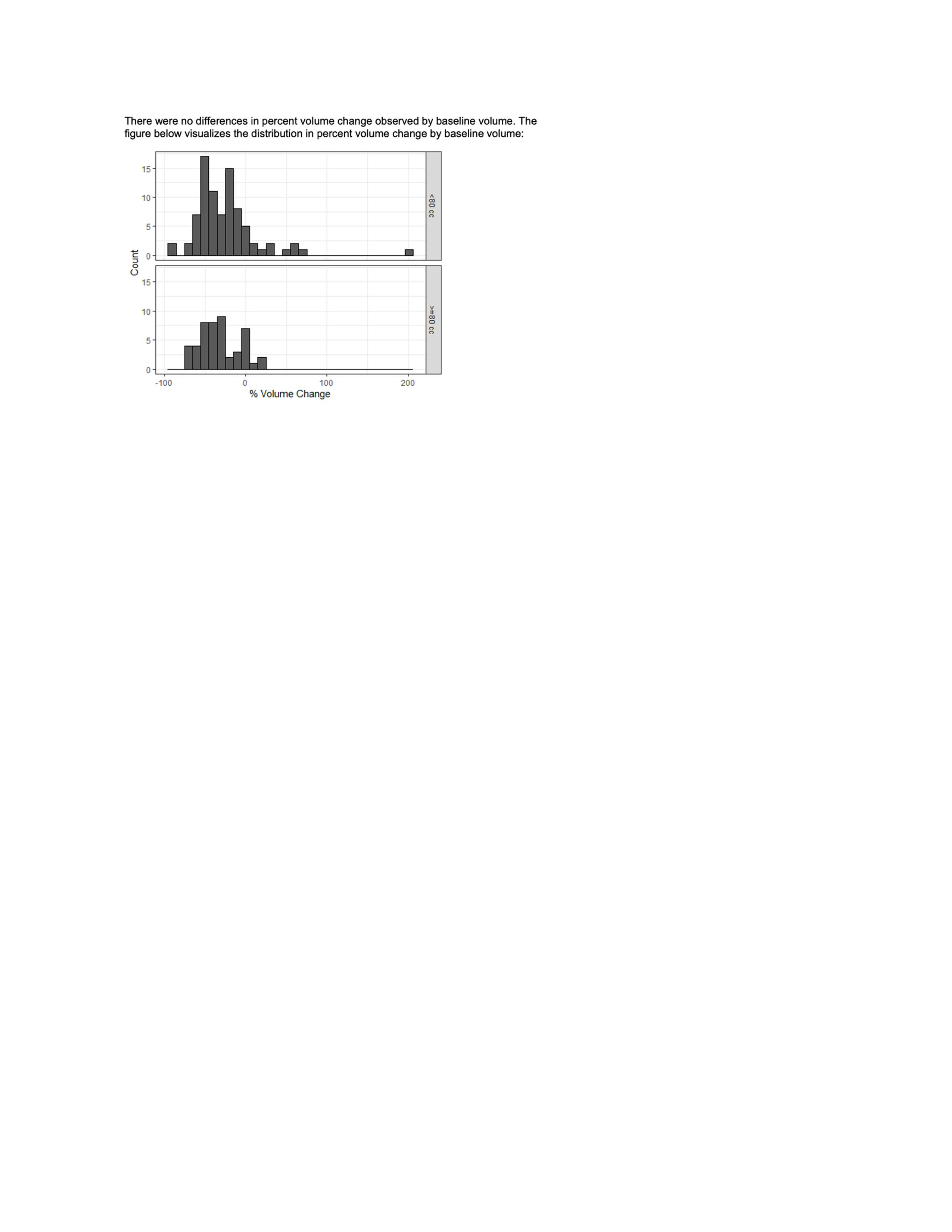Back
Introduction: Rezum convective water vapour thermal therapy is a minimally invasive, office-based treatment for benign prostatic hyperplasia (BPH). While studies have demonstrated its efficacy in symptomatic improvement, its effect on objective measures such as prostate volume (PV) reduction is poorly characterized. The purpose of this study was to evaluate the change in PV in glands above and below 80cc.
Methods: PV was assessed at baseline and 12 months post-procedure. The percent change from baseline PV was calculated for each patient, as was the number of Rezum injections. The percentage of patients achieving a 0-30%, >30% and >50% volume reduction was calculated.
Results: A total of 132 men (mean age = 67.3; standard deviation [SD] = 9.1) underwent the procedure between April 2019 and September 2021, with a median baseline PV of 70.0cc (range 23-195) and median number of vapour injections of 10.0 (range 3-21). At 12 months, the median percent change in prostate volume for the entire cohort was -34.3% (interquartile range: -50.5%, -13.4%), with 55% (n=72) achieving a >30% volume reduction and half of those achieved >50% reduction (n=36). Among patients with PV <80cc (n=84), the median percent change in PV was -34.3% (interquartile range: -50.0%, -13.7%), with 51% (n-43) achieving a >30% reduction and 26% (n=22) achieving a >50% reduction in PV. Among patients with PV >80cc (n=48), the median percent change in PV was -34.6% (interquartile range: -50.9%, -11.9%), with 60% (n-29) achieving a >30% reduction and 29% (n=14) achieving a >50% reduction in PV. There was no difference between the PV groups in volume reduction (p=0.51) and the presence or absence of a median lobe did not influence PV reduction.
Conclusions: In this cohort of men treated with office-based, outpatient Rezum convective water vapour thermal therapy for BPH, prostate volume reduction was consistently around -34% regardless of whether baseline PV was <80cc or >80cc and was not influenced by the presence of a median lobe. SOURCE OF
Funding: No

Moderated Poster Session
Session: MP76: Benign Prostatic Hyperplasia: Surgical Therapy & New Technology IV
MP76-04: Prostate volume reduction by Rezum water vapour thermal therapy in glands <80cc and >80cc
Monday, May 1, 2023
9:30 AM – 11:30 AM CST
Location: S405

Dean Sol Elterman, MD
MD, MSc, FRCSC
University of Toronto
Poster Presenter(s)
Introduction: Rezum convective water vapour thermal therapy is a minimally invasive, office-based treatment for benign prostatic hyperplasia (BPH). While studies have demonstrated its efficacy in symptomatic improvement, its effect on objective measures such as prostate volume (PV) reduction is poorly characterized. The purpose of this study was to evaluate the change in PV in glands above and below 80cc.
Methods: PV was assessed at baseline and 12 months post-procedure. The percent change from baseline PV was calculated for each patient, as was the number of Rezum injections. The percentage of patients achieving a 0-30%, >30% and >50% volume reduction was calculated.
Results: A total of 132 men (mean age = 67.3; standard deviation [SD] = 9.1) underwent the procedure between April 2019 and September 2021, with a median baseline PV of 70.0cc (range 23-195) and median number of vapour injections of 10.0 (range 3-21). At 12 months, the median percent change in prostate volume for the entire cohort was -34.3% (interquartile range: -50.5%, -13.4%), with 55% (n=72) achieving a >30% volume reduction and half of those achieved >50% reduction (n=36). Among patients with PV <80cc (n=84), the median percent change in PV was -34.3% (interquartile range: -50.0%, -13.7%), with 51% (n-43) achieving a >30% reduction and 26% (n=22) achieving a >50% reduction in PV. Among patients with PV >80cc (n=48), the median percent change in PV was -34.6% (interquartile range: -50.9%, -11.9%), with 60% (n-29) achieving a >30% reduction and 29% (n=14) achieving a >50% reduction in PV. There was no difference between the PV groups in volume reduction (p=0.51) and the presence or absence of a median lobe did not influence PV reduction.
Conclusions: In this cohort of men treated with office-based, outpatient Rezum convective water vapour thermal therapy for BPH, prostate volume reduction was consistently around -34% regardless of whether baseline PV was <80cc or >80cc and was not influenced by the presence of a median lobe. SOURCE OF
Funding: No

